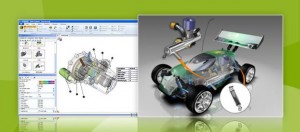Software vendors spend a lot of time and money touting the value of 3D CAD software though most of the attention is paid to the actual design process. After all, this is where engineers and designers focus most of their efforts and where the innovative designs are conceived and realized through the use of 3D CAD software.
Ideas are proposed, explored, vetted, and flushed out during the important conceptual design phase. Then engineers take those evolving concepts and convert them into fully detailed geometry that will eventually be past to manufacturing.
Downstream benefits of 3D data
The use of 3D CAD software has provided tremendous benefits to the design phase of product development, but leveraging that resulting 3D design data elsewhere in the enterprise–and even outside of the corporate walls to partners and suppliers–is where a bounty of potential benefits awaits. Many companies have barely scratched the surface of realizing these downstream benefits of 3D data.
After all, it takes a village, or at least an entire enterprise, to successfully conceive, design, manufacture and get any new product to market. This somewhat Herculean effort requires the carefully coordinated efforts of multiple disciplines, which all play a critical role in the ultimate market success of any product.
While engineering and manufacturing play a starring role in the design-test-build phases of product development, other departments, such as marketing, sales, service quality, training, and technical documentation, also play heavily into the successful rollout and support of final products. These departments are often referred to as off the critical path, but their involvement is still critical.

Despite this, not all companies are taking advantage of leveraging CAD data to these important downstream design consumers. Let’s take a look at how downstream departments can leverage the use of 3D design data and what tasks can be done better by using it.
Better sales proposals. Create proposals that feature fully rendered 3D images and animations and you’ll get an edge on any competition still submitting bids in 2D. Creating proposals in 3D also helps potential customers understand the intricacies of your product.
Better sales tools. Help out your marketing department by providing them with 3D photorealistic renderings of products. Being able to create supporting collateral in advance using 3D CAD data enables marketers to seed the market to assess interest in a new product.
More effective training materials. Instructors can hit the ground running by tapping 3D CAD data to create the technical manuals and tutorials that will be used to help users understand how to ultimately use the product.
Assess maintenance issues. Regardless of how amazing and innovative a new product is, at some point it will be need to be serviced. Document field service procedures using 3D CAD data prior to manufacturing to access how easy or difficult it will be to service that product once built.
Create assembly instructions. Instead of manually creating assembly instructions based on cryptic 2D drawings, 3D assembly models can be quickly and easily “exploded” in 3D CAD to enable folks downstream to easily include these views of a product’s internal components in technical illustrations, assembly instructions and customer documentation.
Collaborate better. Design review teams today have expanded to include many non-technical members, including marketing and sales. Sharing a 3D model with which they can interact can help them understand how a product will function so they can add their input–without having to know how to use a 3D CAD system or interpret a 2D drawing.
The bottom line
The ability to share 3D data downstream with non-engineering departments can deliver significant bang for the buck by increasing productivity, optimizing workflows, and providing non-technical personnel with a voice in the development of new products in design reviews.
In order to realize these benefits, however, companies must educate, train and encourage these downstream design participants to use and understand the extended value of 3D CAD data and how they can use it to be more productive and better contribute to the success of future products.

